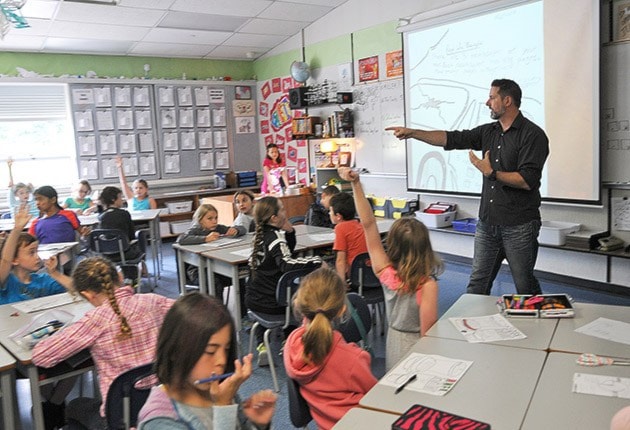Paul Wojcik invites his students back into class from the playground right outside their room’s door at Vedder elementary.
It’s time for the morning math class, and the kids are well aware of it. But they don’t dawdle, and there is no moaning and groaning as they take their seats.
Also missing are the textbooks, worksheets, and calculators.
Instead, the kids hurry back while Wojcik dims the lights and flicks on a projection monitor. He shows his students the four math sheets they can choose from, and they take their turns walking up to get one. Each worksheet is a piece of art created by another teacher in the school, Andy Fast.
It doesn’t take long to see this is no ordinary math lesson. It’s a skills assessment program known as ANIE, and the kids are primed for the exercise. They’ve been learning math the ANIE way since September, and know there will be a chance to be creative, to explore, to experiment and to show off what they know.
Known to educators as the Assessment of Numeracy in Education, the system helps kids tackle math equations in a more creative, backwards mode of thinking. It was written by Kirk Savage, Chilliwack school district’s director of education, and Kevin Bird, assistant superintendent at Fraser Cascade. They’ve been working on ANIE for 10 years, and have seen impressive results in classrooms that have adopted ANIE. In Wojcik’s class, for example, an average of 10 per cent of the students were exceeding expectations in math in the Foundation Skills Assessment. After adopting ANIE, that number is now closer to 70 per cent.
And being successful at anything makes it more enjoyable, encouraging further learning. When Wojcik writes a typical Grade 4 math equation (4,178 x 5 = _ ), his students jot it down on their papers eagerly.
It’s time for them to estimate the answer, using whatever skills each student has mastered. A handful of students are asked to share their estimates out loud.
Some broke it down to 4,000 multiplied by five. Others attempted a more complex estimate with 4,170. The goal is to figure it in their heads within five seconds, and it seems everyone’s on the right track.
Now it’s time to do the math equation, and this goes quickly.
The answer, they tell their teacher, is 20,890. Several students are invited to the projector to show their solution.
Now for the fun part. The part that is sometimes missing from math lessons: What do those numbers mean?
“The ‘solve’ isn’t the problem,” Wojcik said. “It’s the comprehension.”
Math literacy is no different from language literacy in that regard. Similar to language arts, there is deeper meaning to be found in equations. Each math question can be turned into a real life situation. And that’s where ANIE really gets engaging.
That’s where ANIE shows them that math is about more than numbers.
The students are asked to draw a picture that reflects the question. Many of them choose to draw five containers of french fries, each meant to represent 4,170 fries. The total 20,890 fries, naturally, being in their hypothetical stomach.
Other students look at the question a little deeper. Erica Stolz walks to the projector with her worksheet, ready to share her vision of the equation. And it’s a good one, the teacher says, partly because it uses bacon, but also because it digs a bit further into the equation.
“If I make 4,178 eggs, and I want to make five pieces of bacon for each egg, I will make 20,890 pieces of bacon,” she says.
Just like that, the ominous math question has a sense of being useful in the future, if that future means cooking breakfast for approximately 4,000 people who love bacon.
Another student takes yet another approach, deciding that if she received one bag of 4,178 bouncy balls, and her brother received four identical bags, they would have 20,890 in total. The final step is to write out a “real life question” with only words, complete with the answer.
The various answers and probabilities are the magic that happens with ANIE.
“It’s transformational,” says Savage.
ANIE Math was published through Pembroke, and templates are available to download on Savage’s and Bird’s website, along with further information about how to use the teaching tool. There has to be a balance, Savage says, between the computation of math facts and the comprehension of what they mean.
And as the kids are learning math, the teacher is able to look for gaps in their learning and readjust their teaching approach.
For Wojcik, a math fan himself, ANIE is the perfect way to teach not just the fast facts needed for quick processing, but the deeper meaning behind it all.
“This really allows them to think about math in a different way,” he says. “And they’re having fun with it.”
